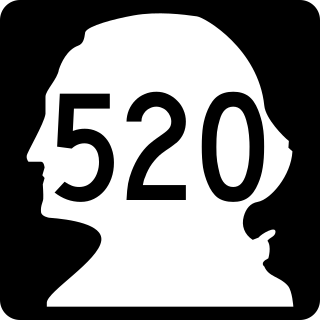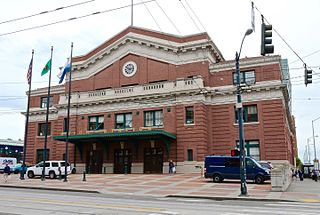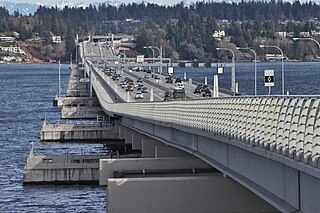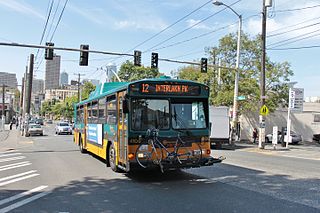Related Research Articles

A bicycle-sharing system, bike share program, public bicycle scheme, or public bike share (PBS) scheme, is a shared transport service where bicycles are available for shared use by individuals at low cost.

State Route 520 (SR 520) is a state highway and freeway in the Seattle metropolitan area, part of the U.S. state of Washington. It runs 13 miles (21 km) from Seattle in the west to Redmond in the east. The freeway connects Seattle to the Eastside region of King County via the Evergreen Point Floating Bridge on Lake Washington. SR 520 intersects several state highways, including Interstate 5 (I-5) in Seattle, I-405 in Bellevue, and SR 202 in Redmond.

Sound Transit (ST), officially the Central Puget Sound Regional Transit Authority, is a public transit agency serving the Seattle metropolitan area in the U.S. state of Washington. It operates the Link light rail system in Seattle and Tacoma, regional Sounder commuter rail, and Sound Transit Express bus service. The agency also coordinates the regional ORCA fare card system, which is also used by local transit operators. In 2019, Sound Transit services carried a total of 48 million passengers and averaged over 161,000 riders on weekdays.

Transportation in Seattle is largely focused on the automobile like many other cities in western North America; however, the city is just old enough for its layout to reflect the age when railways and trolleys predominated. These older modes of transportation were made for a relatively well-defined downtown area and strong neighborhoods at the end of several former streetcar lines, now mostly bus lines.

The South Lake Union Streetcar, officially the South Lake Union Line, is a streetcar route in Seattle, Washington, United States, forming part of the Seattle Streetcar system. It travels 1.3 miles (2.1 km) and connects Downtown Seattle to the South Lake Union neighborhood on Westlake Avenue, Terry Avenue, and Valley Street. The South Lake Union Streetcar was the first modern line to operate in Seattle, beginning service on December 12, 2007, two years after a separate heritage streetcar ceased operations.

Alaskan Way, originally Railroad Avenue, is a street in Seattle, Washington, that runs along the Elliott Bay waterfront from just north of S. Holgate Street in the Industrial District—south of which it becomes East Marginal Way S.— to Broad Street in Belltown, north of which is Myrtle Edwards Park and the Olympic Sculpture Park. The right-of-way continues northwest through the park, just west of the BNSF Railway mainline, and the roadway picks up again for a few blocks at Smith Cove. It follows a route known in the late 19th century as the "Ram's Horn" because of its shape. The street gave its name to the Alaskan Way Viaduct, which until 2019 carried Washington State Route 99 through Downtown Seattle. The northern section of Alaskan Way is also signed as its honorary name, Dzidzilalich.

Northgate is a light rail and bus station in the Northgate neighborhood of Seattle, Washington, United States. It is the northern terminus of the 1 Line on Sound Transit's Link light rail system. The transit center, located adjacent to the Northgate Mall, has four bus bays served by 22 routes. The station also has parking for 1,525 vehicles.

The First Hill Streetcar, officially the First Hill Line, is a streetcar route in Seattle, Washington, United States, forming part of the modern Seattle Streetcar system. It travels 2.5 miles (4.0 km) between several neighborhoods in central Seattle, including the International District, First Hill, and Capitol Hill. The line has ten stops and runs primarily in mixed traffic on South Jackson Street and Broadway.

Michael McGinn is an American lawyer and politician. He served as mayor of the city of Seattle, Washington, and is a neighborhood activist and a former State Chair of the Sierra Club.

The Seattle Streetcar is a system of two modern streetcar lines operating in the city of Seattle, Washington. The South Lake Union line opened first in 2007 and was followed by the First Hill line in 2016. The two lines are unconnected, but share similar characteristics: frequent service, station amenities, and vehicles. Streetcars typically arrive every 10–15 minutes most of the day, except late at night. The streetcar lines are owned by the Seattle Department of Transportation and operated by King County Metro. The system carried 1,093,500 passengers in 2022.
Citi Bike is a privately owned public bicycle sharing system serving the New York City boroughs of the Bronx, Brooklyn, Manhattan, and Queens, as well as Jersey City and Hoboken, New Jersey. Named after lead sponsor Citigroup, it was operated by Motivate, with former Metropolitan Transportation Authority CEO Jay Walder as chief executive until September 30, 2018, when the company was acquired by Lyft. The system's bikes and stations use technology from Lyft.

Bay Wheels is a regional public bicycle sharing system in California's San Francisco Bay Area. It is operated by Motivate in a partnership with the Metropolitan Transportation Commission and the Bay Area Air Quality Management District. Bay Wheels is the first regional and large-scale bicycle sharing system deployed in California and on the West Coast of the United States. It was established as Bay Area Bike Share in August 2013. As of January 2018, the Bay Wheels system had over 2,600 bicycles in 262 stations across San Francisco, East Bay and San Jose.

Broadway is a major north–south thoroughfare in Seattle, Washington. The 1.6-mile-long (2.6 km) arterial runs north from Yesler Way at Yesler Terrace through the First Hill and Capitol Hill neighborhoods to East Roy Street. Broadway East continues north to East Highland Drive. North of there the street is made up of shorter segments: one from just south of East Blaine Street to just north of East Miller Street, another from East Roanoke Street to East Shelby Street, and the last from East Allison Street to Fuhrman Avenue East.

Pronto Cycle Share, branded as Pronto!, was a public bicycle sharing system in Seattle, Washington, that operated from 2014 to 2017. The system, owned initially by a non-profit and later by the Seattle Department of Transportation, included 54 stations in the city's central neighborhoods and 500 bicycles. Motivate operated the system and Alaska Airlines was the program's presenting sponsor. On March 31, 2017, Pronto shut down operations and disassembly of stations began, with the bicycles being offered to other cities that wish to start a similar system.

The Evergreen Point Floating Bridge, also known as the 520 Bridge and officially the Governor Albert D. Rosellini Bridge, carries Washington State Route 520 across Lake Washington from Seattle to its eastern suburbs. The 7,710-foot-long (2,350 m) floating span is the longest floating bridge in the world, as well as the world's widest measuring 116 feet (35 m) at its midpoint.

The RapidRide G Line is a future RapidRide bus service in Seattle, Washington, operated by King County Metro on Madison Street between Downtown Seattle and Madison Valley. The line is projected to open for service in 2024 and cost $133.4 million.

Spin is an electric bicycle-sharing and electric scooter-sharing company. It is based in San Francisco and was founded as a start-up in 2017, launching as a dockless bicycle-sharing system controlled by a mobile app for reservations.

Westlake Avenue is a major street in Seattle, Washington, connecting Downtown Seattle to the neighborhoods of South Lake Union, Westlake and northeastern Queen Anne. The street runs north–south along the west side of Lake Union for 2.5 miles (4.0 km) from McGraw Square to the Fremont Bridge.

Micromobility refers to a range of small, lightweight vehicles operating at speeds typically below 25 km/h (15 mph) and driven by users personally. Micromobility devices include bicycles, e-bikes, electric scooters, electric skateboards, shared bicycle fleets, and electric pedal assisted (pedelec) bicycles.
References
- 1 2 "Funding - Transportation". www.seattle.gov. Retrieved 7 March 2023.
- ↑ Seattle City Council (November 18, 1996). "City of Seattle Ordinance 118409". City of Seattle Legislative Information Service. Office of the City Clerk. Retrieved September 2, 2017.
- ↑ Lewis, Peter (November 19, 1996). "Council OKs $3.7 billion budget". The Seattle Times . p. B3. Retrieved September 2, 2017.
- ↑ Seattle City Council (March 19, 2004). "City of Seattle Ordinance 121420". City of Seattle Legislative Information Service. Office of the City Clerk. Retrieved September 2, 2017.
- ↑ "Seattle Municipal Code Chapter 3.12: Seattle Department of Transportation". City of Seattle. Retrieved September 2, 2017– via MuniCode.
- ↑ "Facts About Seattle: City Officials". Seattle Municipal Archives . Retrieved September 2, 2017.
- ↑ de Luna, Ruby (July 28, 2022). "Meet Seattle's new transportation director: Greg Spotts". KUOW. Retrieved August 18, 2022.
- 1 2 "Seattle Department of Transportation". City of Seattle 2015 Adopted Budget and 2016 Endorsed Budget (PDF) (Report). Seattle City Budget Office. February 17, 2015. p. 426. Retrieved March 3, 2023.
- ↑ "Bridging the Gap — Building a foundation that lasts - Transportation". www.seattle.gov. Retrieved 7 March 2023.
- ↑ Lindblom, Mike (October 25, 2006). "Transportation levy would be biggest ever". The Seattle Times. Archived from the original on 2016-03-04. Retrieved September 2, 2017.
- ↑ Lindblom, Mike (November 8, 2015). "Move Seattle passage means $930M to hit the streets; repaving, school zones first". The Seattle Times. Retrieved September 2, 2017.
- ↑ "Bicycle Program". Seattle Department of Transportation. Retrieved September 2, 2017.
- ↑ Lindblom, Mike (October 2, 2015). "Seattle plans to take over, expand underused Pronto bike-share network". The Seattle Times. Retrieved September 1, 2023.
- ↑ Gutman, David (July 17, 2017). "Bike shares wheeling back into Seattle, but they're unlike Pronto in 2 big ways". The Seattle Times. Retrieved September 1, 2023.
- ↑ Gutman, David (November 10, 2017). "Seattle planner who designed city's bike-share permitting now working for bike-share company". The Seattle Times. Retrieved September 1, 2023.
- ↑ Groover, Heidi (May 9, 2019). "Electric scooters are coming to Seattle, Mayor Jenny Durkan says". The Seattle Times. Retrieved September 1, 2023.
- ↑ Rosenblatt, Lauren (August 31, 2023). "GM's Cruise takes first step to bring its self-driving cars to Seattle". The Seattle Times. Retrieved September 1, 2023.
- ↑ "SDOT Transportation Infrastructure Inventory". Seattle Department of Transportation. December 9, 2015. Retrieved September 2, 2017.